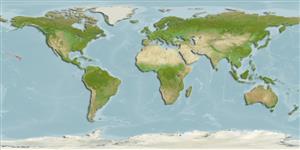Actinopterygii (ray-finned fishes) >
Scorpaeniformes (Scorpionfishes and flatheads) >
Scorpaenidae (Scorpionfishes or rockfishes) > Scorpaeninae
Etymology: Scorpaenopsis: Latin, scorpaena = a kind of fish, 1706 + Greek, opsis = appearance (Ref. 45335). More on author: Randall.
Environment / Climate / Range
Ecology
Marine; reef-associated; non-migratory; depth range 1 - 38 m (Ref. 42181). Tropical; ? - 26°C (Ref. 2272), preferred ?
Eastern Central Pacific: Midway and Hawaiian Islands.
Size / Weight / Age
Maturity: Lm ? range ? - ? cm
Max length : 13.3 cm SL male/unsexed; (Ref. 42181)
Dorsal
spines
(total): 12;
Dorsal
soft rays
(total): 9;
Anal
spines: 3;
Anal
soft rays: 5;
Vertebrae: 24. Pectoral rays usually 19; a blunt head profile, long jaw (21-27% SL); no hump behind head; longest dorsal spine 4-6; 5 spines on the suborbital ridge and 3 on the lachrymal bone overlying the maxillary (Ref. 10482). No black band across anal and pelvic fins; reaches 133 mm SL; snout length 3.2-3.9 in head; interorbital width 6.0-8.8 in head (Ref 42181).
Usually found on rocky bottom or coral reefs, but also on sand and rubble bottom (Ref. 42181). Benthic (Ref. 58302).
Life cycle and mating behavior
Maturity | Reproduction | Spawning | Eggs | Fecundity | Larvae
Randall, J.E and W.N. Eschmeyer, 2001. Revision of the Indo-Pacific scorpionfish genus Scopaenopsis, with descriptions of eight new species. Indo-Pac. Fish. (34):79 p. (Ref. 42181)
IUCN Red List Status (Ref. 115185)
CITES (Ref. 94142)
Not Evaluated
Threat to humans
Harmless
Human uses
Fisheries: of no interest
More information
Common namesSynonymsMetabolismPredatorsEcotoxicologyReproductionMaturitySpawningFecundityEggsEgg development
Age/SizeGrowthLength-weightLength-lengthLength-frequenciesMorphometricsMorphologyLarvaeLarval dynamicsRecruitmentAbundance
ReferencesAquacultureAquaculture profileStrainsGeneticsAllele frequenciesHeritabilityDiseasesProcessingMass conversion
Tools
Special reports
Download XML
Internet sources
